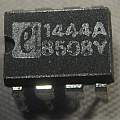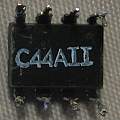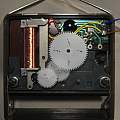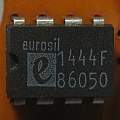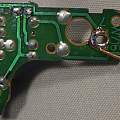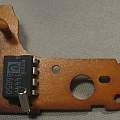(why I am not the bloke who repairs clocks on the TV)
Started 19th May 2021
See Repairing Quartz analogue clocks
I pulled to pieces a couple of clocks that were made in Germany, probably in the 1980's. Noticeable in these old clocks was that they use an 8 pin dip chip marked Eurosil 1444. These are still available but at quite a high price. In both cases the chip stopped functioning correctly.
It is not easy to find a pdf datasheet, doing so is mostly of academic interest. However information is available from a number of web pages [1][2][3].
The pulse length is 47 ms (1/32+1/64=0.047) (with a repetition frequency of 1 Hz). This is the case for both the chips below (1444A and 1444F).
It seems the Intersil ICM7050 is an equivalent and looking at the datasheet for that reveals versions with 47 ms, 31 ms, and 1 second pulse length outputs.
One of these clocks was not keeping time, and looking on the 'scope the pulses to the coil were not regular. I replaced the chip with a "blob on board" clock module taken from a cheap clock. Putting the thing back together I had a bad piece of luck, the shaft of one of the gears sheared off whilst I screwed the case together. I replaced it with a bit of chopped off electronic component lead.
The clock seemed to work, but when put back on the wall it started to stop. Investigating, the little magnet was moving but not doing complete rotations. I concluded this is because the clock module I used gives a 31 ms pulse and as above the original design was for a 47 ms pulse.
This offers an insight, the solenoid pulse has to be strong and long enough to make the magnet turn just over a quarter revolution, from where the permanent magnet will complete the motion. With a low battery some steps may fail and the clock loses time. Eventually all steps fail and the clock stops but carries on making a noise.
Could one stretch the 31 ms pulse - not easy because it is bidirectional - the simple solution of a capacitor would require a relatively high value and they are almost always polarised. Obviously it can be done but I did not want a big piece of electronics - although there was plenty of room.
I fitted a replacement movement to my clock. The fingers on the new movement took up more height, meaning I had to space the clock face back from the glass. Focussing on getting it to work I did not notice the old movement had a wire loop to hang the clock on the wall built in, whilst the new one did not. A bracket had to be made and attached.
Photos. First clock. This is the one I installed a blob on board clock in, which failed to be reliable.
Second clock.
Next week teddy bear bionic repair.
References:
